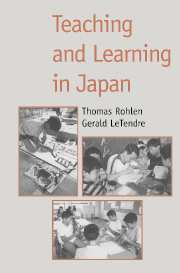Book contents
- Frontmatter
- Contents
- List of contributors
- Introduction: Japanese theories of learning
- Section I Fundamental approaches
- Section II The emotional foundations of early learning
- Section III School and classroom models
- Teachers and teaching: elementary schools in Japan and the United States
- Responsibility and learning: some preliminary hypotheses about Japanese elementary classrooms
- Cultures of mathematics instruction in Japanese and American elementary classrooms
- The Kumon approach to teaching and learning
- Section IV Path and guidance
- Section V Artistic pursuits – old and new
- Conclusion: themes in the Japanese culture of learning
- References
- Index
Teachers and teaching: elementary schools in Japan and the United States
Published online by Cambridge University Press: 05 June 2012
- Frontmatter
- Contents
- List of contributors
- Introduction: Japanese theories of learning
- Section I Fundamental approaches
- Section II The emotional foundations of early learning
- Section III School and classroom models
- Teachers and teaching: elementary schools in Japan and the United States
- Responsibility and learning: some preliminary hypotheses about Japanese elementary classrooms
- Cultures of mathematics instruction in Japanese and American elementary classrooms
- The Kumon approach to teaching and learning
- Section IV Path and guidance
- Section V Artistic pursuits – old and new
- Conclusion: themes in the Japanese culture of learning
- References
- Index
Summary
Ask typical Americans about Japanese education and the answers usually conform to a stereotyped image: intense, highly pressured children learning under the tutelage of a stern, demanding teacher who seeks conformity and stresses mechanical learning and rote memory. Lectures, group recitation, and daily drill characterize the teaching, they would say, and passive docility describes the children. Japanese students, because of the rote learning, lack the creativity and problem-solving skills of American students. It is through this robotlike perfection, many Americans argue, that Japanese students attain their high level of academic competence. They acknowledge the fact that American students may not be competitive in international comparative studies, but they propose that American schools foster the originality and creativity that have made America the superpower it is.
This stereotyped image of Japanese elementary schools is out of date. It may have had some validity in earlier centuries, when children of the noble and warrior classes were required to master classical Chinese and Japanese texts, and it may describe some Japanese middle schools and high schools. But it is an inaccurate description of what occurs today in Japanese elementary schools. These impressions are typically based on brief visits by Westerners who do not know the Japanese language and who know little about Japanese culture. Indeed, Americans are shocked when they have the opportunity to understand what actually goes on in the typical Japanese classroom.
- Type
- Chapter
- Information
- Teaching and Learning in Japan , pp. 157 - 189Publisher: Cambridge University PressPrint publication year: 1996
- 8
- Cited by

